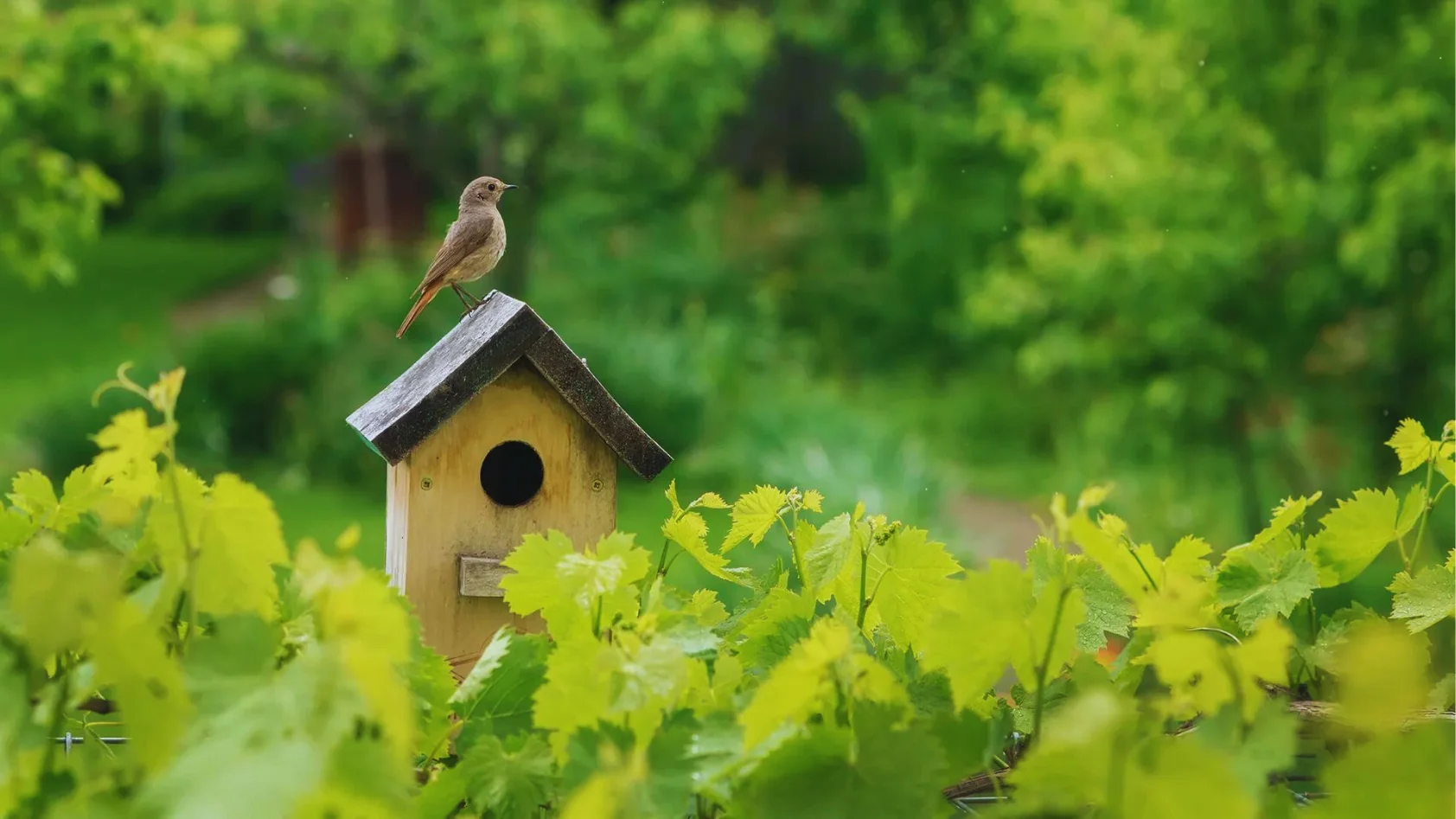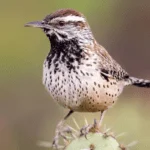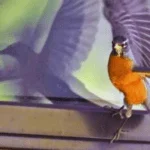Are you a bird lover? Do you enjoy waking up to the cheerful melodies of chirping sparrows? If so, then this article is for you!
Welcome to ‘Birdhouse for Sparrows: Creating a Cozy Nesting Space for Chirpy Residents.’ In this article, we will explore the world of sparrows and learn how to provide them with a safe and comfortable home.
By understanding their needs, choosing the right birdhouse design, and finding the perfect location, you can attract these delightful creatures to your backyard.
We will also discuss the importance of providing nesting materials, monitoring and maintaining the birdhouse, and protecting sparrows and their habitat.
Additionally, we will look at how creating a bird-friendly environment can attract other bird species, allowing you to enjoy the beauty of nature right outside your window.
So, let’s dive in and discover the joy of creating a haven for our feathered friends!
Key Takeaways
- Choosing the right design and location of the birdhouse is crucial for attracting sparrows and creating a cozy nesting space.
- Providing nesting materials such as twigs, grass, and feathers can help encourage sparrows to use the birdhouse.
- Regular monitoring and maintenance of the birdhouse is important to ensure its functionality and attractiveness to sparrows.
- Creating a bird-friendly environment in the yard through bird-friendly practices and using bird mansions can further attract sparrows and enhance their nesting experience.
Understanding the Needs of Sparrows
The key to crafting a birdhouse that will attract sparrows lies in understanding their specific nesting requirements. Sparrows prefer cozy spaces that provide protection from predators and the elements. When designing a birdhouse for sparrows, keep in mind that they like their nests to be concealed and well-hidden.
To begin, choose a birdhouse design that is small and compact. Sparrows prefer a snug fit, so opt for a box-like structure with a small entrance hole. Make sure the entrance hole is no larger than 1.5 inches in diameter, as this will prevent larger birds from entering and taking over.
Next, consider the materials used for the birdhouse. Sparrows prefer natural materials, such as wood or bamboo. These materials provide insulation and mimic the natural nesting sites sparrows typically choose, such as tree cavities or dense shrubs.
When placing the birdhouse, consider the height and location. Sparrows prefer their nests to be around 6-10 feet off the ground, in a location that provides some shade and protection from direct sunlight. Be sure to secure the birdhouse to a sturdy post or tree to prevent it from swaying or falling.
By understanding the specific needs of sparrows and creating a cozy nesting space that meets those requirements, you’ll be sure to attract these chirpy residents to your birdhouse.
Choosing the Right Birdhouse Design
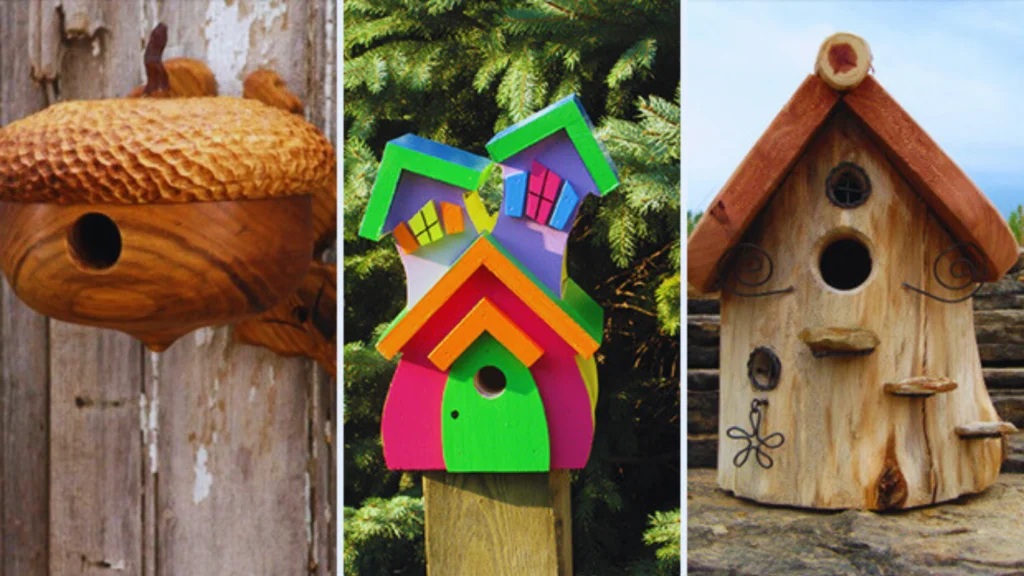
When choosing the right design, have you considered what type of entrance hole size is suitable for the birds you want to attract? Sparrows are small birds, so it’s important to choose a birdhouse with a small entrance hole. A hole that is around 1.25 inches in diameter is perfect for sparrows. This size will prevent larger birds from entering the birdhouse and taking over the nesting space.
Additionally, make sure the entrance hole is located near the top of the birdhouse. Sparrows prefer a higher entrance as it provides them with a sense of security and protection from predators.
Another important factor to consider when choosing a birdhouse design for sparrows is ventilation. The birdhouse should have small ventilation holes near the top to allow for proper air circulation. This will help regulate the temperature inside the birdhouse and prevent it from becoming too hot or stuffy.
Additionally, make sure there is a small drainage hole at the bottom of the birdhouse to allow any rainwater to escape and prevent the nesting materials from getting wet.
Lastly, the materials used in the construction of the birdhouse are important. Choose a birdhouse made of durable and weather-resistant materials such as wood or plastic. Avoid birdhouses made of metal, as they can become too hot in the summer sun.
By considering these factors and choosing the right birdhouse design, you can create a cozy nesting space that sparrows will be attracted to and enjoy calling home.
Location, Location, Location
Looking to attract more feathered friends? Find the perfect spot for your birdhouse and watch as your backyard becomes a hub of avian activity! When it comes to the location of your birdhouse, there are a few key factors to consider.
First and foremost, make sure to place it in an area that is safe from predators. Ideally, the birdhouse should be mounted on a pole or tree at least five feet off the ground. This will help protect the eggs and nestlings from cats and other predators.
In addition to safety, birds also prefer a quiet and peaceful location for their nests. Try to find a spot that is away from busy areas of your yard, such as walkways or play areas. A secluded corner or the edge of your property are great options.
Furthermore, different bird species have different habitat preferences. For example, some birds prefer open spaces, while others like to nest near trees or shrubs. Do a little research on the types of birds you want to attract and find out what kind of habitat they prefer. This will help you choose the best location for your birdhouse.
By finding the right location for your birdhouse, you are providing a safe and comfortable space for sparrows and other birds to nest. So grab your binoculars, find the perfect spot, and get ready to enjoy the sights and sounds of chirping residents in your backyard!
Providing Nesting Materials
When it comes to providing nesting materials for sparrows, there are two main options to consider: natural materials and artificial nesting materials.
Natural materials, such as twigs, leaves, and grass, can be collected from your surroundings and placed near the birdhouse to encourage the sparrows to build their nest.
On the other hand, artificial nesting materials, like cotton balls or pet fur, can be purchased and placed inside the birdhouse to provide a cozy and comfortable environment for the chirpy residents.
Natural Materials
Using natural materials like twigs, leaves, and grass can help you create a cozy birdhouse that blends into the environment. This provides a safe and comfortable space for sparrows to nest while adding natural beauty to your backyard.
Here are some ideas to inspire you:
- Twigs: Use sturdy twigs to create a stable and durable framework for the birdhouse.
- Leaves: Line the inside of the birdhouse with soft leaves to create a cozy nesting space.
- Grass: Fill any gaps or spaces in the birdhouse with dried grass for added insulation and comfort.
- Moss: Add a layer of moss to the exterior of the birdhouse to help it blend seamlessly into the surroundings.
- Pinecones: Attach pinecones as decorative elements for a natural and rustic look.
By incorporating these natural materials, you can attract sparrows and enhance the beauty of your outdoor space.
Artificial Nesting Materials
With a little creativity, you can easily transform ordinary household items into a bird’s dream home. Artificial nesting materials can be a great alternative to natural ones, providing comfort and security to sparrows. These materials are readily available and can be easily obtained. Here is a table showcasing some common household items that can be repurposed as nesting materials:
| Material | Benefits | How to Use |
|---|---|---|
| Twine | Provides structure and support for the nest | Cut into small pieces and weave into the nest |
| Yarn | Adds insulation and warmth | Line the nest with yarn strands |
| Fabric scraps | Soft and comfortable for nesting | Place inside the nest for added comfort |
By incorporating these artificial materials, you can create a cozy nesting space for sparrows, ensuring they have a safe and warm home to raise their young. So, gather your household items and start building a dream home for your chirpy residents!
Monitoring and Maintenance
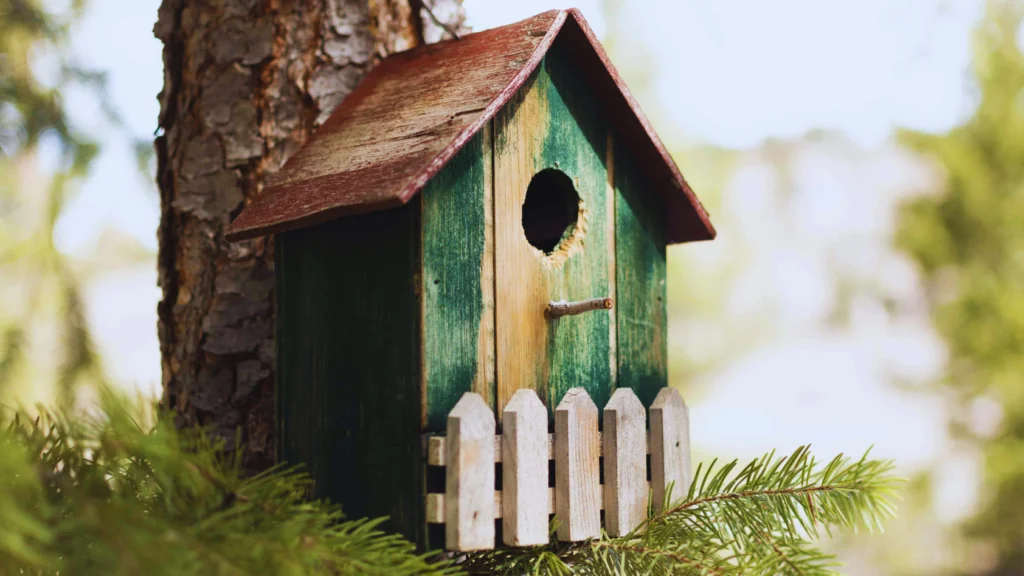
To keep an eye on your sparrow residents, regularly check the birdhouse and gently tap on the walls to listen for the cheerful sound of chirping. This will help you ensure that the sparrows are still nesting and that everything is going well.
Additionally, it is important to monitor the condition of the birdhouse to ensure that it remains a cozy and safe space for the chirpy residents. Look for any signs of damage or wear and tear, such as loose screws or cracks in the wood. If you notice any issues, make the necessary repairs promptly to maintain a comfortable environment for the sparrows.
In terms of maintenance, it is essential to clean the birdhouse regularly. Use a soft brush or cloth to remove any debris or droppings that may have accumulated inside. Cleaning the birdhouse will not only keep it hygienic for the sparrows but also prevent the spread of diseases.
Additionally, during the nesting season, it is important to avoid disturbing the birdhouse too much, as this may cause stress to the nesting sparrows. However, a quick check and gentle tap on the walls every now and then will help you stay connected with your chirpy residents and ensure their well-being in their cozy nesting space.
Providing Food and Water
Don’t forget to make sure your feathered friends have plenty of food and water available. Providing food and water is essential for attracting sparrows and creating a cozy nesting space for them.
Here are five things you can do to ensure your chirpy residents are well-fed and hydrated:
- Hang bird feeders: Sparrows enjoy a variety of seeds, so hang multiple feeders with different types of birdseed. This will attract a diverse range of sparrows and keep them well-fed throughout the year.
- Offer fresh water: Place a shallow birdbath or a small water dish near the birdhouse. Sparrows need water for drinking and bathing, so make sure it is clean and refreshed regularly.
- Plant native plants: Create a bird-friendly environment by planting native plants that produce seeds, berries, or nectar. This will provide a natural source of food for sparrows and attract insects that they feed on.
- Avoid pesticides: Pesticides can be harmful to birds and their food sources. Opt for natural pest control methods or choose bird-friendly alternatives to keep your garden free from pests without harming the sparrows.
- Provide nesting materials: Along with food and water, offer nesting materials such as twigs, leaves, and grass clippings. These materials will help sparrows build their nests and create a safe and comfortable home for their young.
By following these tips, you can ensure that your birdhouse becomes a haven for sparrows, providing them with an abundant supply of food and water.
Landscaping for Sparrows
Planting native plants in your garden can create a lush and inviting landscape for sparrows. Native plants provide a natural habitat for these chirpy residents, attracting them to your garden and encouraging them to make it their home. Not only do native plants offer a familiar environment for sparrows, but they also provide a reliable source of food and shelter.
Incorporating a variety of plants in your landscaping can ensure that sparrows have access to a diverse range of resources. Consider planting shrubs and trees that bear fruits, such as dogwood or elderberry, as these will attract insects that sparrows love to feed on. Additionally, include flowering plants like coneflowers or sunflowers to provide nectar for birds and attract insects for them to eat.
To help you visualize the variety of plants you can incorporate, here is a table showcasing some common native plants and the benefits they offer to sparrows:
| Plant | Benefit |
|---|---|
| Dogwood | Provides berries that attract insects, a food source for sparrows |
| Elderberry | Produces berries that are a favorite of sparrows, attracting them to your garden |
| Coneflower | Attracts insects for sparrows to feed on |
| Sunflower | Provides nectar for birds and attracts insects, a food source for sparrows |
By landscaping your garden with native plants, you can create an inviting and nourishing environment for sparrows, ensuring their comfort and well-being.
Protecting Sparrows and Their Habitat

Transform your garden into a safe haven, a sanctuary where sparrows can thrive and their habitat can flourish. By taking simple steps to protect sparrows and their habitat, you can make a significant difference in their survival.
First and foremost, avoid using harmful pesticides in your garden. These chemicals not only harm the insects that sparrows rely on for food but can also contaminate their nesting sites. Instead, opt for organic pest control methods or encourage natural predators like ladybugs and birds of prey to visit your garden.
Another way to protect sparrows is by providing suitable nesting sites. Install birdhouses specifically designed for sparrows, with small entrance holes to keep out larger birds. Place them in safe, quiet areas away from predators and make sure to clean them out regularly to prevent the spread of diseases.
Furthermore, planting native plants in your garden can provide a vital source of food for sparrows. Native plants attract insects, which are an essential part of the sparrow’s diet. Additionally, these plants provide natural cover and nesting materials, creating a more inviting habitat for sparrows.
Lastly, keep your cat indoors. Domestic cats are one of the biggest threats to bird populations, including sparrows. By keeping your cat inside, you not only protect sparrows but also help prevent the spread of diseases.
By following these simple guidelines, you can make a significant impact on the protection of sparrows and their habitat. Your garden will become a haven for these chirpy residents, ensuring their survival for generations to come.
Attracting Other Bird Species
If you want to attract other bird species to your backyard, there are a few key points to keep in mind.
First, creating a bird-friendly environment is essential. This can be done by providing a variety of food sources, such as bird feeders and native plants that produce berries or seeds.
Additionally, providing additional nesting spaces, such as birdhouses or nesting boxes, can also help attract a wider range of bird species.
Creating a Bird-Friendly Environment
To encourage sparrows to nest in your yard, you can make it more bird-friendly by providing a variety of food sources and creating natural habitat structures. Here are four ways to create a bird-friendly environment:
- Plant native trees and shrubs: These provide food and shelter for birds, attracting them to your yard. Choose species that produce berries, seeds, or nectar to cater to different bird species.
- Install bird feeders: Place feeders in different locations around your yard and fill them with a variety of seeds, such as sunflower and millet. This will attract sparrows and other bird species, providing them with a consistent food source.
- Add a birdbath: Birds need water for drinking and bathing. Install a shallow birdbath with fresh water, and keep it clean and filled year-round.
- Provide nesting materials: Place materials like twigs, grass, and feathers in your yard for birds to use in building their nests. This will make your yard more inviting to sparrows and encourage them to stay and nest.
Providing Additional Nesting Spaces
One option for providing additional nesting spaces for birds is by installing a luxurious bird mansion in the yard. These structures are designed to attract various bird species, including sparrows, and provide them with a cozy and secure place to build nests. Bird mansions often feature multiple compartments with different sizes and shapes, accommodating the preferences of different bird species. They are made of durable and weather-resistant materials, ensuring long-lasting use.
To attract sparrows specifically, it is important to include small entrance holes and an open design that allows easy access. Adding nesting materials such as twigs, grass, and feathers inside the compartments can further entice sparrows to make these luxurious bird mansions their new homes.
Enjoying and Appreciating Sparrows
When it comes to enjoying and appreciating sparrows, there are two key points to consider.
First, observing their behavior can provide valuable insights into their daily lives and interactions with other birds.
Second, listening to their songs can be a delightful experience, as sparrows are known for their cheerful and melodic tunes.
By taking the time to observe and listen to sparrows, you can gain a deeper appreciation for these chirpy residents and the unique role they play in the bird world.
Observing Their Behavior
Examine the behavior of the sparrows by setting up a discreet observation point near their birdhouse. Watch as these small, energetic birds go about their daily activities, providing a fascinating glimpse into their world. Here are some behaviors you might observe:
- Nest Building: Sparrows are skilled architects, meticulously constructing their nests using twigs, grass, and feathers. Witness their dedication as they gather materials and carefully arrange them to create a cozy home for their young.
- Feeding Rituals: Notice how the sparrows take turns visiting the bird feeder, gracefully hopping from branch to branch. Watch as they peck at seeds and insects, their beaks moving with precision and speed.
- Social Interactions: Observe the sparrows’ social dynamics as they communicate through a series of chirps and calls. Witness their playful interactions, with occasional squabbles over territory or food.
In this quiet observation, you’ll gain a deeper appreciation for these delightful creatures and the intricate behaviors that make them unique.
Listening to Their Songs
As you quietly observe, you’ll be enthralled by the melodious songs that fill the air, creating a symphony of sweet and harmonious notes.
Listening to their songs is a delightful experience that offers valuable insights into the sparrow community. Their songs are a form of communication, expressing various emotions and messages.
You’ll notice different patterns and melodies, each unique to a specific situation or occasion. The male sparrows use their songs to attract mates and establish territory, while the females respond with their own calls.
By listening attentively, you can decipher their intricate language and understand their needs and desires. The songs also serve as a way for sparrows to bond and strengthen social connections within the group.
So, take a moment to immerse yourself in the enchanting melodies and learn more about the vibrant world of these chirpy residents.
Connecting with the Birding Community
If you have a love for birds and want to connect with like-minded individuals, consider joining birding groups or clubs in your area.
These communities provide a great opportunity to learn from experienced birders, share your own experiences, and participate in group birding outings.
By joining such a group, you can expand your knowledge, make new friends, and contribute to the wider birding community.
Joining Birding Groups or Clubs
Joining birding groups or clubs is a fantastic way to connect with fellow enthusiasts and discover new ways to create cozy nesting spaces for sparrows. By joining these groups, you can expand your knowledge and learn from others who share your passion for birding.
Here are a few benefits of joining birding groups:
- Networking opportunities: Meet like-minded individuals who can provide valuable insights and advice on creating birdhouses for sparrows.
- Field trips and workshops: Participate in group outings and workshops where you can learn new techniques and exchange ideas with experienced birders.
- Access to resources: Gain access to resources such as books, websites, and forums that can help you enhance your birding skills and knowledge.
- Conservation efforts: Collaborate with others to contribute to conservation efforts by creating bird-friendly habitats and promoting awareness about the importance of sparrows.
Joining birding groups or clubs is a fantastic way to connect with others and make a difference in the lives of sparrows by creating cozy nesting spaces for them.
Sharing Your Experiences and Knowledge
Immerse yourself in a world of awe-inspiring tales and wild adventures as you share your birding experiences and knowledge with fellow enthusiasts. By joining birding groups or clubs, you have the opportunity to connect with like-minded individuals who are equally passionate about the feathered creatures. Sharing your experiences not only brings joy and excitement but also contributes to the collective knowledge and understanding of birds. Through lively discussions and storytelling, you can learn from others and inspire them with your own encounters. Additionally, your knowledge can make a difference in conservation efforts and help in protecting the habitats of these chirpy residents. So, don’t hesitate to share your stories, tips, and insights, and watch as the birding community grows closer and stronger.
| Emotion | Description | Example |
|---|---|---|
| Excitement | Feel the rush of spotting rare species | “I couldn’t believe my eyes when I saw a vibrant blue-throated hummingbird!” |
| Wonder | Marvel at the intricate beauty of bird nests | “The intricacy and precision of the weaver bird’s nest left me in awe.” |
| Connection | Forge lifelong friendships through shared birding experiences | “Bonding over our love for owls, we became instant friends.” |
| Amazement | Be amazed by the incredible migratory journeys of birds | “The sheer distance that Arctic terns travel every year is mind-boggling!” |
| Inspiration | Inspire others with your birding stories | “My encounter with a majestic bald eagle motivated others to take up birding.” |
Birdhouse For Sparrows Frequently Asked Questions
Can sparrows use any type of birdhouse, or are there specific designs that work best for them?
Sparrows can use different types of birdhouses, but there are specific designs that work best for them. These designs typically have a small entrance hole and a cozy interior to provide a safe and comfortable nesting space for sparrows.
How often should the birdhouse be cleaned and maintained?
To keep your birdhouse tidy and inviting, clean it out once a year before the nesting season. Remove old nests, scrub with a mild solution, and let it air dry. Regular maintenance ensures happy chirpy residents.
What are some common predators of sparrows and how can I protect them from harm?
Common predators of sparrows include cats, snakes, and birds of prey. To protect them, keep the birdhouse elevated and away from potential hiding spots for predators. Regularly check the area for signs of danger.
Can I attract other bird species to my birdhouse and if so, how can I do that?
You can attract other bird species to your birdhouse by providing a variety of food, water, and shelter options. Use different feeders and birdhouses designed for specific species to create a welcoming environment.
Are there any specific plants or flowers I can include in my landscaping to further attract sparrows to my yard?
To attract sparrows to your yard, plant a variety of shrubs and trees, like honeysuckle and dogwood, which provide food and shelter. “Killing two birds with one stone,” your landscaping will create an inviting habitat for these chirpy residents.
Conclusion
So, now you know how to create a cozy nesting space for sparrows! By understanding their needs, choosing the right birdhouse design, and providing nesting materials, you can attract these chirpy residents to your backyard.
Did you know that sparrows can lay up to 5-6 eggs per clutch, and they can have multiple clutches in a season? Imagine the joy of seeing those little eggs hatch and watching the baby sparrows grow!
Take action today and create a birdhouse that will not only benefit sparrows but also enhance your connection with the birding community.

